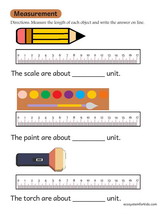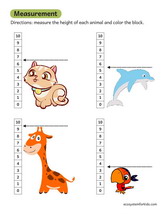Measurement worksheets length & Height 1st Grade
This page features measurement worksheets length / height for 1st grade. This concept is something we all experience daily. You are always measuring objects and finding out how long or how short they are. You are also trying to figure out how tall or short your friend is compared to you. In these sheets, children will practice measuring objects using a rule. The sheets are all free to download and are in pdf format.
Measurements 1st Grade - Using a Ruler to Compare Lengths
As your child learns about measurements, introduce the following concepts and vocabulary. Measure objects with a ruler and discuss how to compare lengths. You should also discuss how to use standard units of measure. For more tips, check out our 1st Grade Measurements Worksheet here. You can also find some other resources to support your child's learning. Measurements are an important part of early childhood education. So make sure they are incorporated into your child's curriculum early on.
Measuring with a ruler
Measuring with a ruler in first grade requires that students know how to measure the length of objects. They should use a ruler with black markings representing centimeters, inches, and tenths. Students must align the end of an object with the zero point of the ruler. Then they need to count the units and mark the value of the object. This knowledge is important for students to succeed later.
Measuring with a friend
Throughout first grade, your child has learned about measurements. They have been determining lengths and volumes using objects in their environment, such as a ruler and tape measure. In these lessons, you will not only learn about lengths, but also about volume and weight. Your child can use these concepts to estimate the amount of a particular object, and the activity will be fun for both of you. A great way to bring this knowledge to a hands-on level is to involve a friend. Ask your friend to help you hold the ends of a piece of tape and work together to determine the length of different items. This will be a lot of fun.
Using a ruler to compare lengths
Using a ruler to compare lengths is an important skill for students learning to understand the concept of length. In kindergarten, students learned to measure objects by measuring them to the nearest inch. Now that students have learned to use a ruler as a measuring tool, they will quickly recognize it as a model for lengths and understand its importance in daily life. It's time to take a ruler and measure and compare the lengths of everyday objects like your watch, school bag, table, and more. Compare them and find out which objects are longer or shorter.
Line up objects starting from the zero mark
Using a ruler to measure objects in first grade is simple: just align an object on the ruler, starting at the zero mark. Depending on what unit of measurement you are using, your ruler may have centimeter or inch marks. Then, starting at the zero mark, align your object with the edges of the ruler. You can then mark the value of the object on the ruler.
The object should be placed at the zero mark of the ruler, not at the end of the ruler. Then they count the lengths of two objects and mark the values accordingly. Once the measurement is complete, they can add the measurements to determine the distance between the two objects.


